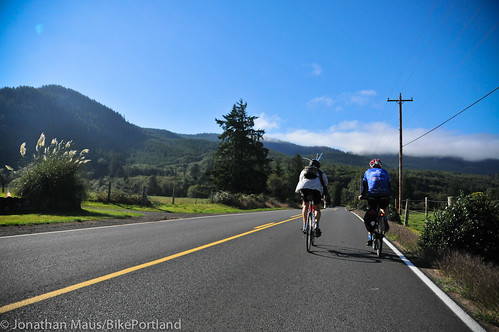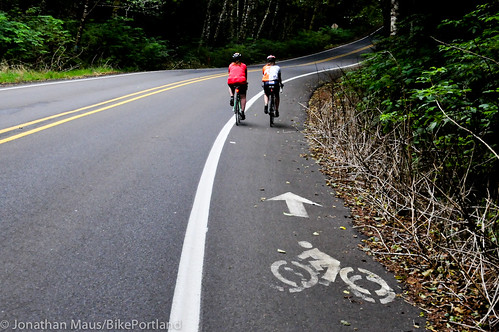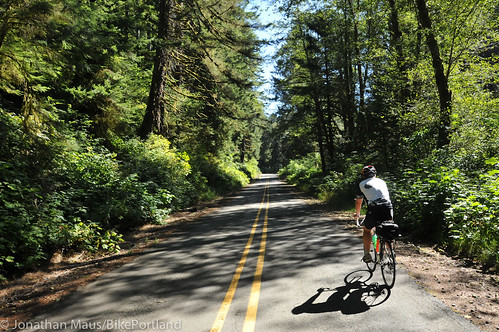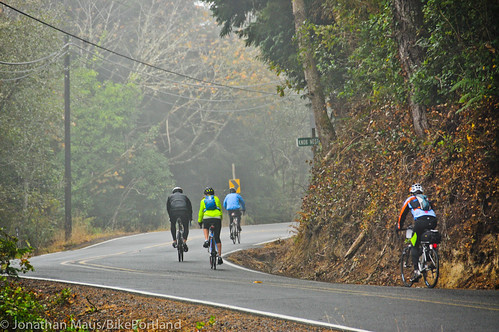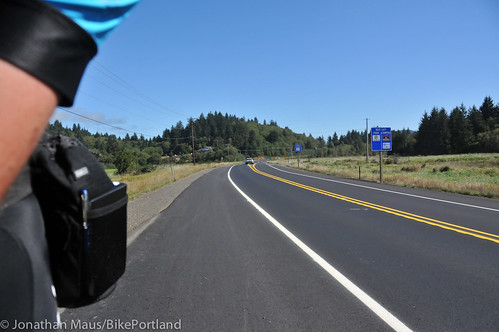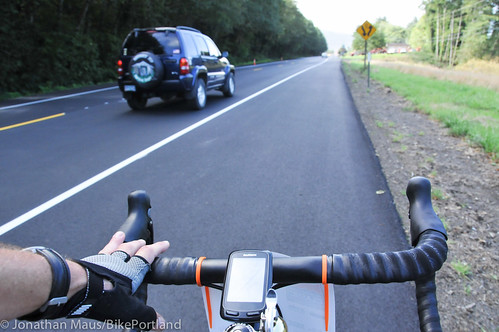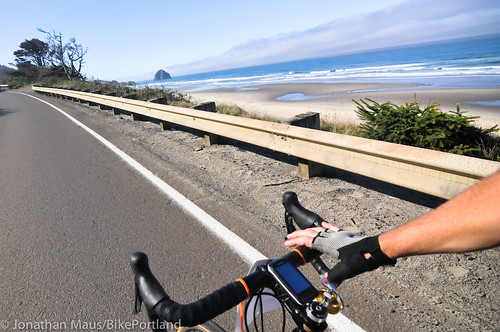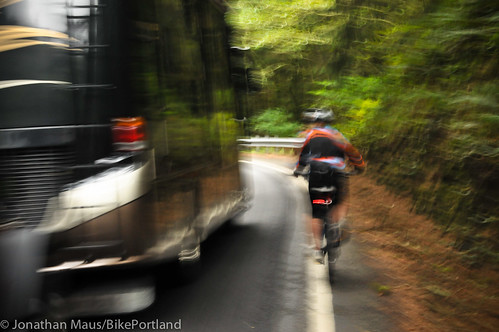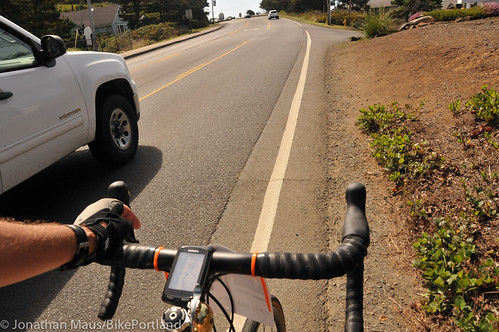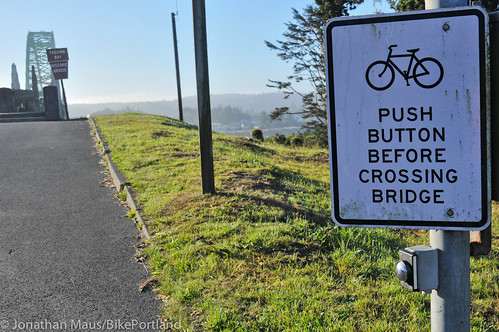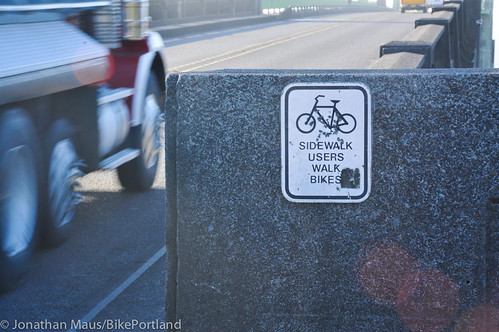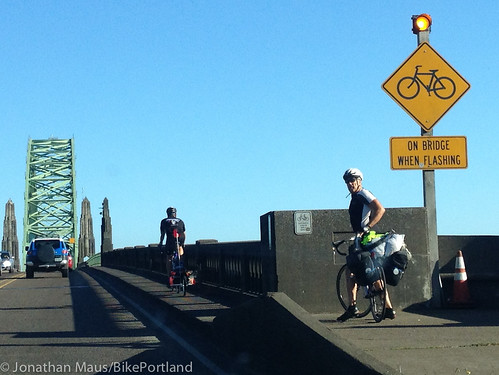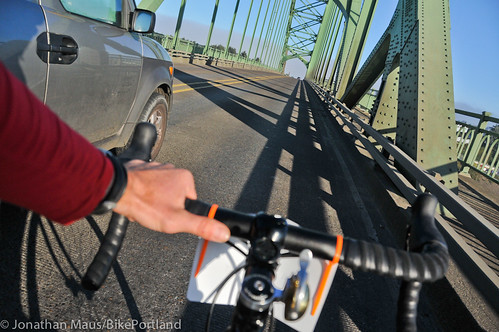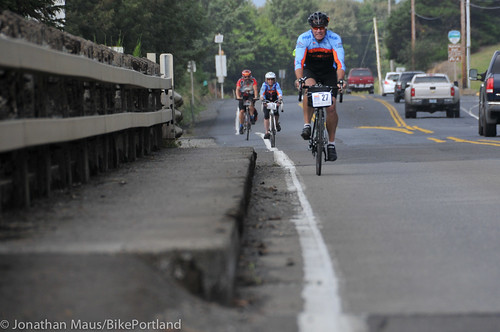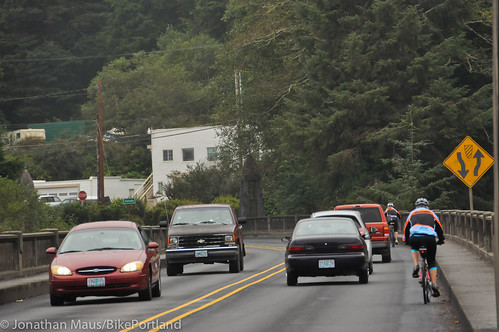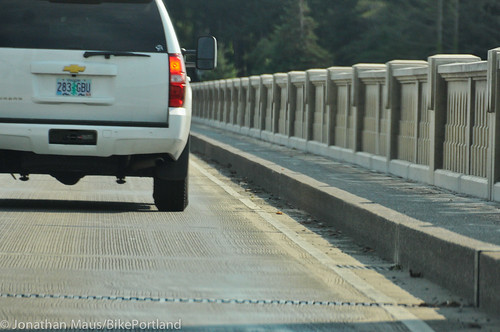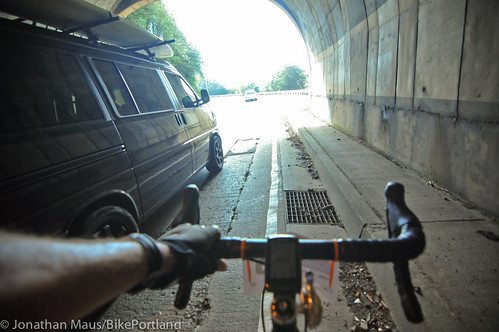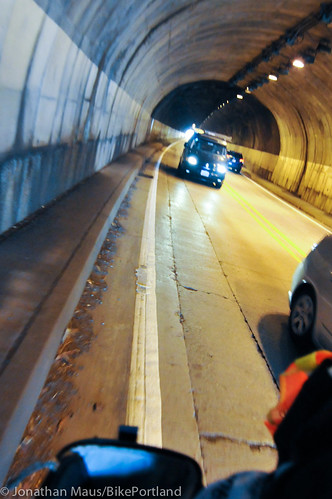Last week I joined about 50 other folks for a ride down the Oregon Coast Bike Route. In six days of pedaling, we covered about 370 miles — most of it along the shoulder of Highway 101. This route isn’t just one of the premier cycle touring routes in the world, it’s also an official Scenic Byway (as designated by the U.S. Department of Transportation), a key commercial corridor that fuels Oregon’s timber industry, and an artery for the many cities and towns it passes through.
During my ride I tried to pay special attention to how these widely different uses of the road are balanced both by the users themselves and by the agency in charge of Highway 101, the Oregon Department of Transportation (ODOT).
Before heading south from Astoria to start the ride, I was prepared for the worst. As part of my daily job, I follow police news statements from all over the state, so I am well-aware of the carnage that occurs on Highway 101. From my vantage point, it seems like every other month or so there is a fatal or serious injury collision somewhere on the route. Add in several high-profile collisions that have claimed the lives of people riding bicycles in the past few years, and suffice it to say, I was a bit apprehensive about exposing myself to the logging trucks, massive RVs, and other hazards for six full days. And it didn’t help that many readers, upon hearing about my plans, offered foreboding advice like, “I wouldn’t be caught dead riding on Highway 101,” or the one that really got me, “I wouldn’t do that ride if I had a family to come home to.” (Gee! Thanks for the good thoughts!)
What I actually discovered out on the road, was that the route wasn’t as bad as I thought it would be. I found it to be a very mixed bag: Some sections were like Russian roulette, while others offered a glimpse of what a world-class coast route could look like.
Let’s start with the good.
By far the best parts of the Oregon Coast Bike Route are the sections off the highway. Once you leave that well-worn thoroughfare you’re treated to the splendors of the Oregon Coast undiluted by exhaust, loud engines, or inconsiderate drivers. Memorable sections where we left the roar of Highway 101 behind included: Three Capes Scenic Route south of Tillamook which took us from Netarts Bay through Cape Lookout State Park and then Pacific City;
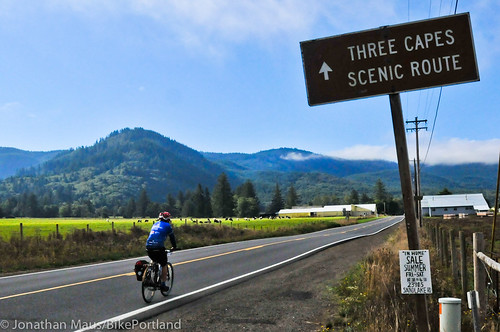
(Near Cape Lookout, there was actually a functioning bike lane for several miles)
Neskowin Scenic Drive (a.k.a. Slab Creek Road);
Otter Crest Loop near Cape Foulweater;
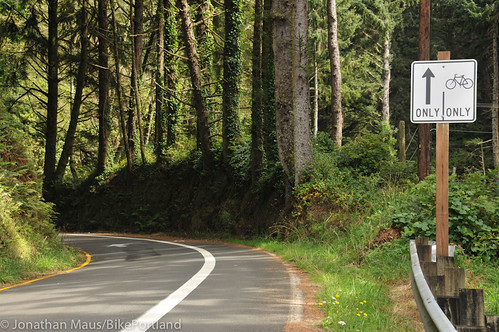
Seven Devils Road south of North Bend (part of the Charleston to Bandon Scenic Tour Route);
and Old Coast Road near Gold Beach.
Those diversions from 101 and the few other detours and side trips I discovered thanks to my trusty GPS device (Cape Blanco State Park and Floras Lake), were the highlights of the trip.
The other places where the Coast Route shines are locations where ODOT has paved wide and smooth shoulders. While far from the physically separated cycling path we dream about; having a wide, smooth and clean shoulder to ride on lowers a riders’ blood pressure considerably — even in the presence of large and fast-moving motor vehicles.
And finally, among the good things on the route are the relatively consistent presence of Oregon Coast Bike Route signs. While they often preside over inadequate conditions (more on that below), and many of them could use a refresh, at least they were there.
And now for the bad.
When you’re riding just a few feet from fast-moving, large motor vehicles, it doesn’t take much to create a bad cycling environment. At too many locations along the Coast Route, ODOT has failed to maintain the shoulder and the resulting cycling conditions are unpleasant and dangerous. At a minimum there should be regularly scheduled maintenance in the peak cycling season that’s performed specifically with cycling in mind.
I also noticed several locations where the soil adjacent to the highway is eroding and ODOT has simply moved the guardrail further into the shoulder. Unfortunately as they move the guardrail over, they don’t re-paint the stripe so the net result is a narrower space for cycling. This also happens when other things like vegetation (and in some cases sand) encroach onto the road. ODOT should consider re-painting the lane lines to maintain a minimum and consistent width for the shoulder. In general, I think ODOT should make a much greater effort to maintain a 4-6 wide shoulder whenever possible.
And finally, the ugly.
Bridges, tunnels and cities are the places on the Oregon Coast Route where, in my opinion, ODOT completely fails to live up to their responsibilities.
On Coast Route bridges, there’s usually very limited space for riding. However, instead of doing anything to impede or slow down people in cars, the onus for safety and life preservation is almost always put on bike riders. On larger bridges like the Yaquina Bay Bridge in Newport, ODOT gives people on bikes no good options.
If you choose to “take the lane” on the bridge, you are told to push a button before crossing that engages a single flashing yellow light at the entry to the bridge that’s accompanied by a sign that reads, “Bikes on Bridge When Flashing.”
I followed these directions on the Yaquina Bay Bridge and got honked and yelled at repeatedly by people in cars wanting to speed past me.
If you aren’t confident enough to ride on the main bridge roadway (and I wouldn’t blame anyone given how intimidating it is), ODOT commands you to walk your bike on the sidewalk. I am sort of against this option on principle alone, not to mention the sheer inconvenience of walking 1-2 miles when a bicycle is meant to be ridden. (It’s worth noting that the director of the ride I was on (the Amgen People’s Coast Classic) didn’t even let us ride on the Coos Bay Bridge that leads into North Bend. He feels that bridge is simply too dangerous and he didn’t want to risk any mishaps so he organized several cars to shuttle riders across.)
While the large bridges tend to get most of the attention, I found that the dozens of smaller bridges along the Coast Route are also more dangerous for cycling than they should be. Countless times I was biking along in the shoulder, only to look up and notice that the shoulder — and often the stripe that designates it — disappeared as it crosses the bridge. In its place was usually a large curb that jutted out into the shoulder and narrowed the roadway. This puts people on bicycles even closer to adjacent traffic and there was never any warning about “Bicycles on Bridge Roadway” or any pavement markings to facilitate the situation.
Tunnels along the Oregon Coast Bike Route are perhaps the scariest — and ugliest — parts of the route. Similar to large bridges, ODOT’s bike safety practice for tunnels consists of button-pushing and flashing lights on yellow signs. The Arch Cape Tunnel is perhaps the weakest link on the entire route and many people have scary stories to share about it. Not only is the paltry flashing signal and sign ineffective at encouraging courteous driving, the extremely narrow shoulder inside the tunnel was full of debris. Add poor/non-existent lighting and a few recessed storm drain grates in the shoulder and you have a terrible cycling environment.
My proposal for ODOT on tunnels and bridges is to scrap the silly flashing light and sign. Instead, create “No passing when bicycles are present” zones. These bridges and tunnels are all quite short in length. Isn’t the safety of other road users more important than a few seconds saved?
Overall, the Coast Route wasn’t as bad as I expected. In fact, with a few tweaks here and there, and more TLC and attention to detail from ODOT, it could be vastly improved. Some day I would like to see a physically separated cycle path the entire length of the coast. But until then, ODOT needs to understand that the quality of the Oregon Coast Bike Route — which is an international tourism draw that pumps thousands of dollars into the small towns along the route every year — is only as good as its weakest link.
— Read more about my ride on the Oregon Coast Bike Route here and view more photos in the gallery.



